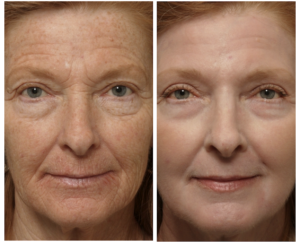

Experience the Most Powerful Anti-Aging Peel Yet!
Imagine looking in the mirror and seeing a smoother, younger, more radiant version of yourself. With the Croton Peel, this transformation is not just a dream
Buff away wrinkles and blemishes for a smoother, younger-looking complexion.
Procedure Summary
Chemical peels use a controlled application of acid to gently remove dead skin cells and stimulate new growth.
Average Cost
$100-200
Time Duration
30 minutes to 45 minutes per session
Alternate Names
Medical Grade Facials, Glow Peel, Power Glow Peel, Jessner Peel
Check out these before and after photos of past Chemical Peel patients of Dr. James Lacey. These photos can give a realistic idea of the amazing facial contour improvements you can achieve through this surgery.
The idea of reversing years of skin damage in a non-invasive and virtually painless way is universally appealing. That’s why chemical peels have become a popular choice for those looking to fight the signs of aging.
A chemical peel, uses a specialized chemical solution to improve your skin’s appearance. During the treatment, this solution is applied to your skin, causing a controlled injury to its layers. As the damaged skin layers peel away, they reveal fresher, more youthful skin underneath. This new skin is typically smoother, with fewer lines and wrinkles, a more even tone, and a brighter complexion.
Thanks to our aestheticians and the innovative technology at Kanata Plastic and Cosmetic Surgery, the latest chemical peels result in minimal downtime. They’re also more powerful and effective than ever before.
There are three different types of chemical peels that you can get. These include:
Type of Peel | Description | Ideal For | Recovery Time |
Superficial Peels (Available at KPCS) AHA, Renew 30, BHA, Glow Peel, Power Glow | A gentle resurfacing treatment that uses alpha-hydroxy acids (AHAs) like glycolic or lactic acid to buff away the outermost layer of your skin (stratum corneum). | Beginners or those with concerns like sun damage or uneven skin tone. | Minimal to none. |
Medium Peels | Slightly stronger peels that use trichloroacetic acid (TCA) or higher concentrations of AHAs to penetrate deeper into the top layer of your skin (epidermis) and even reach the upper layer of your dermis. | Those with deeper wrinkles, moderate sun damage, or stubborn dark spots (post-inflammatory hyperpigmentation or PIH). | Moderate downtime as the skin sheds the treated layers. |
Deep Peel | Often formulated with phenol or high concentrations of TCA. Deliver the most dramatic results by reaching the lower layers of your dermis. | Individuals seeking significant improvement for deeper wrinkles or scars | Longer healing process with more potential side effects. Thorough consultation with a professional like Dr. James Lacey is recommended |
There’s a chemical peel for just about every common skin concern. Here are the top ten benefits of getting a chemical peel:
Topical acne treatments can only do so much, but a peel goes deeper. By exfoliating more thoroughly, peels cleanse your skin and reveal a fresh new layer and assist with killing acneic bacteria and oils.
Large pores can be a nuisance. Removing the outer, often damaged layer of skin with a peel helps make pores look smaller and less noticeable.
Chemical peels can help by diminishing fine lines and softening even the toughest wrinkles.
A peel can remove the spots of sun, hyperpigmentation and discolorations, helping you feel vibrant.
The chemicals in a peel can help reduce the appearance of many scars.
Uneven skin tone and blemishes can add unwanted texture to your skin. Chemical peels creates a more even and consistent skin texture.
Peels are renowned for their skin-smoothing benefits. By lifting the rigid layers of skin from your face, neck, or hands, you’re left with gorgeously smooth and touchable skin.
Generally, superficial peels can be used on all skin types. However, if you have a darker skin tone, you are at a greater risk of experiencing a darkening of your skin after treatment, known as post-inflammatory hyperpigmentation. It’s advisable to consult one of our medical estheticians about less aggressive treatments to minimize this risk.
Chemical peels may also not be recommended if you:
You’ll start by discussing your skin goals with our medical esthetician. Together, you’ll determine the appropriate type of chemical peel that suits your needs.
On the day of the procedure, your skin is cleansed with an agent to remove excess oils, makeup, and skin products already on the skin.
A chemical solution, such as glycolic acid, salicylic acid, or lactic acid, or phenol, is applied to your skin. Each type of chemical penetrates to a different depth, causing a controlled injury that will eventually peel away.
During the application, you may feel a warm to hot, tingly sensation for 5-20 minutes. To relieve the sensation, a handheld fan may be used.
After the desired effect is achieved, the chemical solution is neutralized. If appropriate, your esthetician may apply skin products to the area after your treatment, but this depends on the type of peel. By the end of the procedure, you'll be on your way to revealing a fresh, new layer of skin.
To schedule your consultation, simply call our Cosmetic
Patient Coordinators at 613-591-1099 or complete the
contact form below. We are here to support you through
your journey and look forward to assisting you!
Chemical peels offer a tempting solution for rejuvenating your skin, but it’s important to be aware of the potential side effects before deciding if it’s right for you.
Some temporary side effects include changes in skin colour (redness), which can be more common in people with certain skin tones or hormonal imbalances. Scarring is a rare but possible risk, especially on certain areas of the face or for those prone to scarring.
If you have a history of cold sore outbreaks, there’s a slight chance a peel could trigger one, but medication can help prevent this. Keloids, or raised scar tissues, are a concern for people with a predisposition to them. Finally, while infections are uncommon, following our esthetician’s aftercare instructions carefully is essential to minimize this risk.
The after-effects of a chemical peel depend on its depth:
After Chemical Peel Expectations | Light Chemical Peel | Medium Chemical Peel |
Immediate Reactions | Sunburn-like redness | Sunburn-like-redness, stinging, flaking. |
Post-Treatment Care | Apply lotion/cream until healed. Use daily sunscreen post-healing. May have mild flaking, do not pick or peel the skin. | Apply lotion/cream daily, avoid sun exposure until healed. Mild to moderate flaking but do not pick or peel the skin. |
Makeup Use | Immediately or next day. | After 1-2 days. |
Additional Treatments | Repeat every 2-5 weeks for 3-5 sessions until desired results are achieved. | Repeat every 3-4 weeks until desired results are achieved. |
After a chemical peel, your skin will be extra sensitive, so be gentle with it. Here's how to care for your skin and prevent complications: Skip the sun exposure. Avoid tanning beds and limit time outdoors, especially during peak sun hours. Make sunscreen a daily habit, even on cloudy days. Apply moisturizer daily as recommended by our medical estheticians to keep your skin hydrated and promote healing. This will also help prevent scarring. Avoid retinol and If you have any questions or concerns after treatment, contact us right away.
A Chemical Peel can cost in the range of $100-$200.
It depends. The strength of the peel and your skin type will determine how much flaking may happen after your treatment. Not everyone peels, regardless of the strength of treatment, but that doesn’t mean you aren’t benefiting from the treatment.
If you’re planning to be in the sun for a prolonged period, we’d suggest waiting to book your chemical peel. You need to be diligent with your sun exposure and protection after treatment to avoid additional inflammation of the skin. Also, if you have an event scheduled and you want to look your best, we suggest booking your peel at least 2 weeks before hand.
While some at home “peels” may be available for purchase, they won’t have the same effect as our medical grade chemical peels, and we aren’t deeply knowledgeable on all the available take home products sold elsewhere. Due to the concentration of ingredients, the types of peels we offer are not available for patients to buy themselves.
You may need to stop using certain topical prescriptions or over-the-counter products, such as retinols, prior to your chemical peel. It’s best to book your consultation with a medical esthetician and provide a full list of medications and skin care products so we can let you know if there are any contraindications.
This depends on your individual skin goals. Are you looking to refresh your skin before an event or are you looking to rejuvenate your skin to address certain concerns? Sometimes, a single treatment is all patient’s are looking for, it’s just enough to get your skin glowing before a friend’s wedding or graduation. If you’re trying to address skin concerns, you may need a series of 4-6 treatments to target those concerns and maintenance treatments after to keep up your results. It’s best to consult one of our medical estheticians to discuss your goals to know which is best for you.
The time between chemicals can vary from patient to patient depending on their skin type and their goals. On average, chemical peels are usually spaced 2-4 weeks apart. At minimum, we like to suggest chemical peels to everyone 4 times a year, once with each change of season just to give our skin a bit of help while the elements are changing.


Imagine looking in the mirror and seeing a smoother, younger, more radiant version of yourself. With the Croton Peel, this transformation is not just a dream


Valentine’s Day is all about celebrating love—and this year, we’re helping you love the skin you’re in! Kanata Plastic Surgery is excited to share our


Why Cosmetic Fillers Might be Right For You Cosmetic fillers are a non–surgical type of cosmetic treatment used for facial rejuvenation and enhancing overall facial


9 Reasons to Choose our Private Surgical Facility over a Public Hospital When it comes to plastic surgery, there are many options available. While many


Will Botox Get Rid of Wrinkles ? Botox is a popular treatment for wrinkles that is becoming increasingly popular. It is a type of injectable

EXCELLENT rating
Based on 70 reviews

We’re offering an exclusive opportunity to trial this revolutionary treatment under the expert care of Dr Lacey & expert, Dr. Richard Bensimon.